山东省菏泽市第三中学2016届高三上学期开学第一考英语试题
- 格式:doc
- 大小:150.50 KB
- 文档页数:14
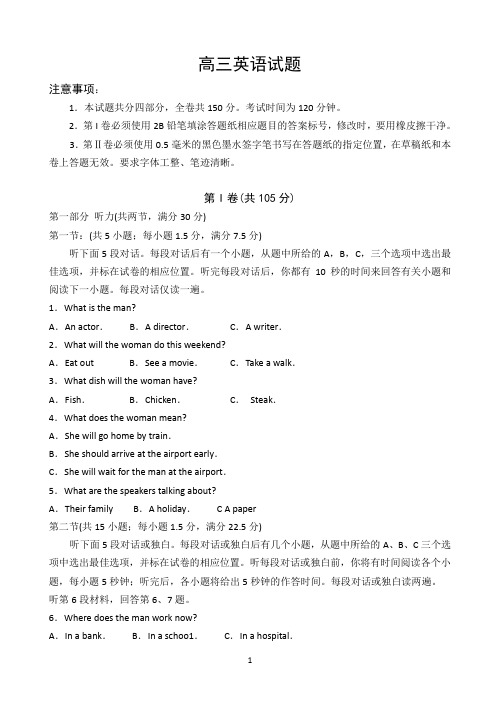
高三英语试题注意事项:1.本试题共分四部分,全卷共150分。
考试时间为120分钟。
2.第I卷必须使用2B铅笔填涂答题纸相应题目的答案标号,修改时,要用橡皮擦干净。
3.第Ⅱ卷必须使用0.5毫米的黑色墨水签字笔书写在答题纸的指定位置,在草稿纸和本卷上答题无效。
要求字体工整、笔迹清晰。
第I卷(共105分)第一部分听力(共两节,满分30分)第一节:(共5小题;每小题1.5分,满分7.5分)听下面5段对话。
每段对话后有一个小题,从题中所给的A,B,C,三个选项中选出最佳选项,并标在试卷的相应位置。
听完每段对话后,你都有10秒的时间来回答有关小题和阅读下一小题。
每段对话仅读一遍。
1.What is the man?A.An actor.B.A director.C.A writer.2.What will the woman do this weekend?A.Eat out B.See a movie.C.Take a walk.3.What dish will the woman have?A.Fish.B.Chicken.C.Steak.4.What does the woman mean?A.She will go home by train.B.She should arrive at the airport early.C.She will wait for the man at the airport.5.What are the speakers talking about?A.Their family B.A holiday. C A paper第二节(共15小题;每小题1.5分,满分22.5分)听下面5段对话或独白。
每段对话或独白后有几个小题,从题中所给的A、B、C三个选项中选出最佳选项,并标在试卷的相应位置。
听每段对话或独白前,你将有时间阅读各个小题,每小题5秒钟;听完后,各小题将给出5秒钟的作答时间。
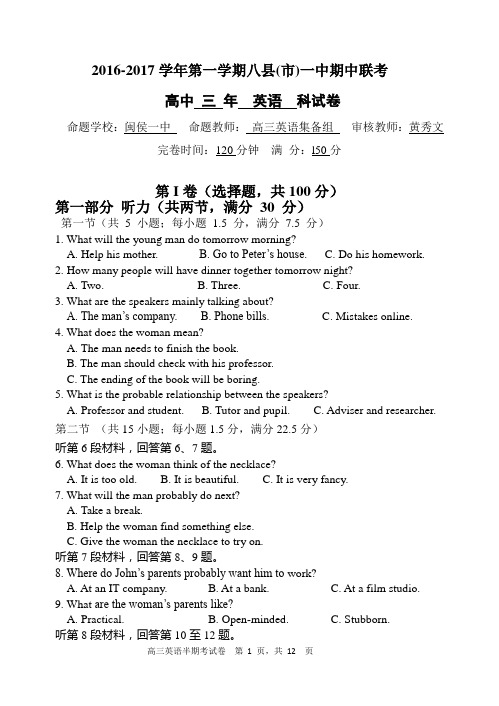
2016-2017学年第一学期八县(市)一中期中联考高中三年英语科试卷命题学校:闽侯一中命题教师:高三英语集备组审核教师:黄秀文完卷时间:120分钟满分:l50分第I卷(选择题,共100分)第一部分听力(共两节,满分30 分)第一节(共5 小题;每小题1.5 分,满分7.5 分)1. What will the young man do tomorrow morning?A. Help his mother.B. Go to Peter’s house.C. Do his homework.2. How many people will have dinner together tomorrow night?A. Two.B. Three.C. Four.3. What are the speakers mainly talking about?A. The man’s company.B. Phone bills.C. Mistakes online.4. What does the woman mean?A. The man needs to finish the book.B. The man should check with his professor.C. The ending of the book will be boring.5. What is the probable relationship between the speakers?A. Professor and student.B. Tutor and pupil.C. Adviser and researcher. 第二节(共15小题;每小题1.5分,满分22.5分)听第6段材料,回答第6、7题。
6. What does the woman think of the necklace?A. It is too old.B. It is beautiful.C. It is very fancy.7. What will the man probably do next?A. Take a break.B. Help the woman find something else.C. Give the woman the necklace to try on.听第7段材料,回答第8、9题。

黑龙江省哈三中2015—2016上学期高三学年第一次测试英语试题第I 卷第一部分:听力(共两节,满分30 分)第一节(共5 题;每小题1.5 分,满分7.5 分)听下面5 段对话。
每段对话后有一个小题,从题中所给的A、B、C 三个选项中选出最佳选项,并标在试卷的相应位置。
听完每段对话后,你有10 秒钟的时间来回答有关小题和阅读下一小题。
每段对话仅读一遍。
1. How many students are there at the school this year?A. 300.B. 400.C. 700.2. What does the man decide to sell?A. His CDs.B. His camera.C. His bike.3. What programme will be shown after the news?A. A food programme.B. A cartoon movie.C. A football match.4. What information does the man want?A. Flights.B. Hotels.C. Cars.5. Where are the speakers?A. On the road.B. At a stadium.C. In an office.第二节(共15 题;每小题 1.5 分,满分22.5 分)听下面5 段对话或独白。
每段对话或独白后有几个小题,从题中所给的A、B、C 三个选项中选出最佳选项,并标在试卷的相应位置。
听每段对话或独白前,你将有时间阅读每个小题,每小题5 秒钟;听完后,各小题将给出5 秒钟的作答时间。
每段对话或独白读两遍。
听第6 段材料,回答第6, 7 题。
6. What should Jack do when he gets off the bus?A. Cross the road.B. Turn left.C. Turn right.7. Where is the man’s house?A. In front of a shop.B. Near a bookstore.C. Behind a school.听第7 段材料,回答第8, 9 题。
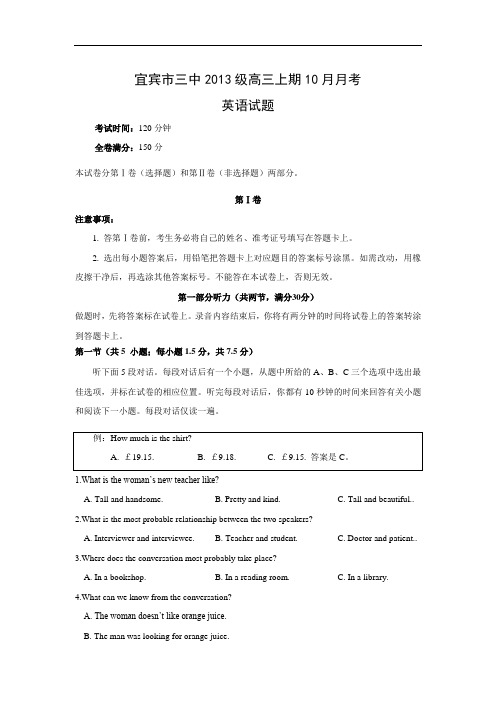
宜宾市三中2013级高三上期10月月考英语试题考试时间:120分钟全卷满分:150分本试卷分第Ⅰ卷(选择题)和第Ⅱ卷(非选择题)两部分。
第Ⅰ卷注意事项:1. 答第Ⅰ卷前,考生务必将自己的姓名、准考证号填写在答题卡上。
2. 选出每小题答案后,用铅笔把答题卡上对应题目的答案标号涂黑。
如需改动,用橡皮擦干净后,再选涂其他答案标号。
不能答在本试卷上,否则无效。
第一部分听力(共两节,满分30分)做题时,先将答案标在试卷上。
录音内容结束后,你将有两分钟的时间将试卷上的答案转涂到答题卡上。
第一节(共5 小题;每小题1.5分,共7.5分)听下面5段对话。
每段对话后有一个小题,从题中所给的A、B、C三个选项中选出最佳选项,并标在试卷的相应位置。
听完每段对话后,你都有10秒钟的时间来回答有关小题和阅读下一小题。
每段对话仅读一遍。
1.What is the woman’s new teacher like?A. Tall and handsome.B. Pretty and kind.C. Tall and beautiful..2.What is the most probable relationship between the two speakers?A. Interviewer and interviewee.B. Teacher and student.C. Doctor and patient..3.Where does the conversation most probably take place?A. In a bookshop.B. In a reading room.C. In a library.4.What can we know from the conversation?A. The woman doesn’t like orange juice.B. The man was looking for orange juice.C. The man broke the container of juice.5. How much does a pen cost?A. One dollar.B. Two dollars.C. Three dollars.第二节(共15小题;每小题1.5分,满分22.5分)听下面5段对话或独白。
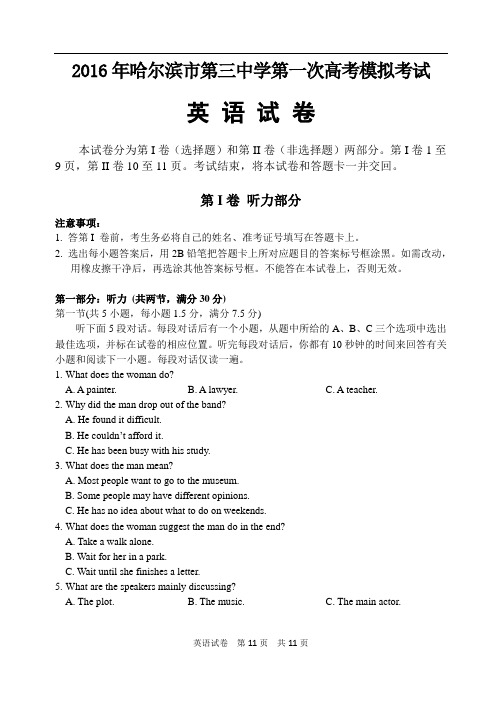
2016年哈尔滨市第三中学第一次高考模拟考试英语试卷本试卷分为第I卷(选择题)和第II卷(非选择题)两部分。
第I卷1至9页,第II卷10至11页。
考试结束,将本试卷和答题卡一并交回。
第I卷听力部分注意事项:1. 答第I 卷前,考生务必将自己的姓名、准考证号填写在答题卡上。
2. 选出每小题答案后,用2B铅笔把答题卡上所对应题目的答案标号框涂黑。
如需改动,用橡皮擦干净后,再选涂其他答案标号框。
不能答在本试卷上,否则无效。
第一部分:听力(共两节,满分30分)第一节(共5小题,每小题1.5分,满分7.5分)听下面5段对话。
每段对话后有一个小题,从题中所给的A、B、C三个选项中选出最佳选项,并标在试卷的相应位置。
听完每段对话后,你都有10秒钟的时间来回答有关小题和阅读下一小题。
每段对话仅读一遍。
1.What does the woman do?A. A painter.B. A lawyer.C. A teacher.2.Why did the man drop out of the band?A. He found it difficult.B. He couldn’t afford it.C. He has been busy with his study.3.What does the man mean?A. Most people want to go to the museum.B. Some people may have different opinions.C. He has no idea about what to do on weekends.4.What does the woman suggest the man do in the end?A. Take a walk alone.B. Wait for her in a park.C. Wait until she finishes a letter.5.What are the speakers mainly discussing?A. The plot.B. The music.C. The main actor.第二节(共15小题, 每小题1.5分,满分22.5分)听下面5段对话。
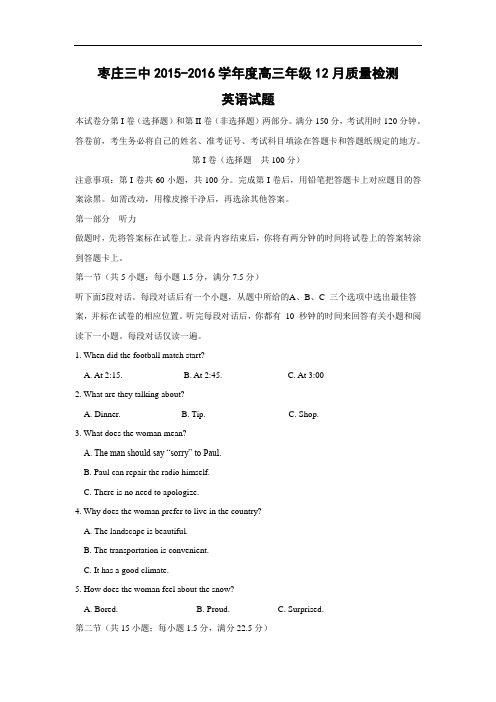
枣庄三中2015-2016学年度高三年级12月质量检测英语试题本试卷分第I卷(选择题)和第II卷(非选择题)两部分。
满分150分,考试用时120分钟。
答卷前,考生务必将自己的姓名、准考证号、考试科目填涂在答题卡和答题纸规定的地方。
第I卷(选择题共100分)注意事项:第I卷共60小题,共100分。
完成第I卷后,用铅笔把答题卡上对应题目的答案涂黑。
如需改动,用橡皮擦干净后,再选涂其他答案。
第一部分听力做题时,先将答案标在试卷上。
录音内容结束后,你将有两分钟的时间将试卷上的答案转涂到答题卡上。
第一节(共5小题;每小题1.5分,满分7.5分)听下面5段对话。
每段对话后有一个小题,从题中所给的A、B、C 三个选项中选出最佳答案,并标在试卷的相应位置。
听完每段对话后,你都有10 秒钟的时间来回答有关小题和阅读下一小题。
每段对话仅读一遍。
1. When did the football match start?A. At 2:15.B. At 2:45.C. At 3:002. What are they talking about?A. Dinner.B. Tip.C. Shop.3. What does the woman mean?A. The man should say “sorry” to Paul.B. Paul can repair the radio himself.C. There is no need to apologize.4. Why does the woman prefer to live in the country?A. The landscape is beautiful.B. The transportation is convenient.C. It has a good climate.5. How does the woman feel about the snow?A. Bored.B. Proud.C. Surprised.第二节(共15小题;每小题1.5分,满分22.5分)听下面5段对话或独白。
哈三中2015-2016学年度上学期高三学年第一次测试英语试卷第I卷第一部分:听力(共两节,满分30分)第一节(共5题;每小题 1.5分,满分7.5分)听下面5段对话。
每段对话后有一个小题,从题中所给的A、B、C三个选项中选出最佳选项,并标在试卷的相应位置。
听完每段对话后,你有10秒钟的时间来回答有关小题和阅读下一小题。
每段对话仅读一遍。
1.How many students are there at the school this year?A.300.B.400.C.700.2.What does the man decide to sell?A.His CDs.B.His camera.C.His bike.3.What programme will be shown after the news?A.A food programme.B.A cartoon movie.C.A football match.4.What information does the man want?A.Flights.B.Hotels.C.Cars.5.Where are the speakers?A.On the road.B.At a stadium.C.In an office.第二节(共15题;每小题 1.5分,满分22.5分)听下面5段对话或独白。
每段对话或独白后有几个小题,从题中所给的A、B、C三个选项中选出最佳选项,并标在试卷的相应位置。
听每段对话或独白前,你将有时间阅读每个小题,每小题5秒钟;听完后,各小题将给出5秒钟的作答时间。
每段对话或独白读两遍。
听第6段材料,回答第6,7题。
6.What should Jack do when he gets off the bus?A.Cross the road.B.Turn left.C.Turn right.7.Where is the man’shouse?A.In front of a shop.B.Near a bookstore.C.Behind a school.听第7段材料,回答第8,9题。
2016届山东省冠县第三中学高三开学初检测理科数学试题第Ⅰ卷(选择题,共60分)一、选择题(本大题共12个小题,每小题5分,共60分.在每小题给出的四个选项中,只有一项是符合题目要求的). 1.设全集{}123456U =,,,,,,{}12A =,,{}234B =,,,则()U A C B =( )A .{}1256,,,B .{}1C .{}2D .{}1234,,,2.若复数()32z i i =- (i 是虚数单位),则z = A .32i - B .32i +C .23i +D .23i -3. 设n S 是数列}{n a 的前n 项和,若3531=++a a a ,则=5SA .5B .7C .9D .114.设f (x)=102,0xx x ⎧-≥⎪⎨<⎪⎩,则f (f (-2))=A .-1B .14C .12D .325.10的展开式中的有理项且系数为正数的项有( ) A .1项 B .2项 C .3项 D .4项 6. 一个几何体的三视图如图所示,则该几何体的表面积为A .3πB .4πC .2π+4D .3π+47.执行如图所示的程序框图,如果输入3n =,则输出的S =( )A .67 B .37 C .89D .498.设:12,:21xp x q <<>,则p 是q 成立的( )A .充分不必要条件B .必要不充分条件C .充分必要条件D .既不充分也不必要条件9.函数sin 26y x π⎛⎫=-⎪⎝⎭的图像与函数cos 3y x π⎛⎫=-⎪⎝⎭的图像( ) A 有相同的对称轴但无相同的对称中心 B 有相同的对称中心但无相同的对称轴 C 既有相同的对称轴但也有相同的对称中心 D 既无相同的对称中心也无相同的对称轴10.不等式组2204x y -≤≤⎧⎨≤≤⎩表示的点集为M ,不等式组220x y y x-+≥⎧⎨≥⎩表示的点集记为N ,在M 中任取一点P ,则P N ∈的概率为( ) A .716 B .916 C .732 D .93211、已知双曲线22221(0,0)x y a b a b-=>>与抛物线28y x =有一个共同的焦点F ,两曲线的一个交点为P ,若5PF =,则点F 到双曲线的渐近线的距离为( )A .2 C D .312.对一定义域为D 的函数()y f x =和常数c ,若对任意正实数ξ,x D ∃∈使得0()f x c ξ<-<恒成立,则称函数()y f x =为“敛c 函数”,现给出如下函数:参加人数A CE ①()()f x x x Z =∈ ②()1(1()2xf x x Z =+∈ ③()2log f x x = ④()1x f x x-=其中为“敛1函数”的有( )A .①②B .③④C .②③④D .①②③ 二、填空题(本大题共4小题,每小题5分,共20分).13.过函数f (x)=3x -23x +2x +5图像上一个动点作函数的切线,则切线倾斜角的范围是________________.14、已知函数()22sin cos 1f x x x x =+-的图象关于直线(02x πϕϕ=≤≤对称,则ϕ的值为 .15.已知函数213,10()132,01x g x x x x x ⎧- -<≤⎪=+⎨⎪-+<≤⎩,若方程()0g x mx m --=有且仅有两个不等的实根,则实数m 的取值范围是 .16.已知抛物线2:4C y x =上一点P ,若以P 为圆心,PO 为半径作圆与抛物线的准线l 交于不同的两点,M N ,设准线l 与x 轴的交点为A ,则11AM AN+的取值范围是 .三、解答题:(本大题共6小题,共70分).17.在ABC ∆中,角,,A B C 对应的边分别是,,a b c ,已知23cos cos 23sin sinC 2cos B C B A +=+.(I)求角A 的大小;(II)若5b =,5sin sin 7B C =,求△ABC 的面积S .(12分)18.如图所示的多面体中,EA ⊥平面ABC ,DB ⊥平面ABC ,BC AC ⊥,且22====AE BD BC AC ,M 是AB 的中点. (Ⅰ)求证:CM ⊥EM ; (Ⅱ)求平面EMC 与平面BCD 所成的锐二面角的余弦值. (12分)19.学校高一年段在上学期依次举行了“法律、环保、交通”三次知识竞赛活动,要求每位同学至少参加一次活动.高一(1)班50名学生在上学期参加该项活动的次数统计如图所示. (1)从该班中任意选两名学生,求他们参加活动次数不相等的概率.(2)从该班中任意选两名学生,用ξ表示这两人参加活动次数之差的绝对值,求随机变量ξ的分布列及数学期望E ξ.(3)从该班中任意选两名学生,用η表示这两人参加活动次数之和,记“函数2()1f x x x η=--在区间(3,5)上有且只有一个零点”为事件A ,求事件A 发生的概率. (12分) 20.椭圆的上顶点为是C 上的一点,以AP 为直径的圆经过椭圆C 的右焦点F . (1)求椭圆C 的方程;(2)动直线l 与椭圆C 有且只有一个公共点,问:在x 轴上是否存在两个定点,它们到 直线l 的距离之积等于1?如果存在,求出这两个定点的坐标;如果不存在,说明理由. (12分)21.已知函数()(1)(13)f x mx nx =+-.(1)若1,()1m y f x x ===求曲线在的切线方程;(2) 若函数()f x 在(0,)+∞上是增函数,求实数m 的取值范围;(3) 设点1122(,()),(,())A x f x B x f x 满足1212121.131(.)8,()nx nx n x x x x =-≠,判断是否存在点P (m,0),使得以AB 为直径的圆恰好过P 点,说明理由. (12分)请在22、23、24三题中任选一题作答,如果多做,则按所做的第一题计分.作答时用2B 铅笔在答题卡上把所选题目的题号后的方框涂黑.22.选修4-1:几何证明选讲如图,AB 切O 于点B ,直线D A 交O 于D ,E 两点,C D B ⊥E ,垂足为C .(I )证明:C D D ∠B =∠BA ;(II )若D 3DC A =,C B =O 的直径.(10分)A23. 选修4—4:极坐标与参数方程在直角坐标系xOy 中,以原点O 为极点,x 轴的正半轴为极轴,建立极坐标系. 已知曲线C 1:4cos ,3sin ,x t y t =-+⎧⎨=+⎩ (t 为参数), C 2:8cos ,3sin ,x y θθ=⎧⎨=⎩(θ为参数)。
2016年菏泽一中高三3月月考(文科)(英语)学校:___________姓名:___________班级:___________考号:___________I、听力-单选题(本大题共20小题,共15.0分)1.What does the woman want to do?A.Turn off the TV.B.Watch the program.C.Take a rest.2.What will the woman probably do next?A.Close the door.B.Pay for the rent.C.Go to another place.3.What is troubling the man about the history course?A.He has failed in the exam.B.He has to read many books.C.He can't follow the teacher.4.What does the man suggest the woman do?e a dictionary.B.Wait until tomorrow.C.Ask someone for help.5.What are the speakers talking about?A.Popularity of the show.B.Chance of getting tickets.C.Price of the tickets.听第6段材料,回答第6、7题。
6.What does the man usually buy online?A.Clothes.B.Office supplies.C.Soft drinks.7.In which case will the websites refuse to take clothes back?A.When the buyer doesn't like them.B.When clothes have been tried on.C.When clothes have been dirtied.听第7段材料,回答第8、9题。
福建省正曦中学2016届高三上学期开学第一考英语试题注意事项:答案必须写在答题卡上,答在试卷上无效。
本试卷分第Ⅰ卷(选择题)和第Ⅱ卷(非选择题)两部分,本试卷满分120分。
考试时间120分钟。
第Ⅰ卷(选择题共70分)第一节(共5小题;每小题1分,满分5分)听下面5段对话,每段对话后有一个小题,从题中所给的A,B,C三个选项中选出最佳选项,并标在试卷的相应位置。
听完每段对话后,你都有10秒钟时间来回答有关小题和阅读下一小题。
每段对话仅读一遍。
1. What will the man do on Sunday?A. Play tennisB. Play football.C. Go swimming.2. What is the woman going to do?A. Buy herself a pair of shoes.B. Buy a gift for the man.C. Attend a birthday party.3. Why is the woman tired?A. She saw a movie.B. She took an exam.C. She studied all night.4. What are the speakers talking about?A. Time.B. Money.C. A movie.5. What is the man doing at the airport?A. Flying to New York city.B. Waiting for his sister.C. Arriving at New York city.第二节(共15小题;每小题1分,共15分)听下面5段对话或独白。
每段对话或独白后有几个小题,从题中所给的A,B,C三个选项中选出最佳选项,并标在试卷相应位置。
听每段对话或独白前,你将有时间阅读各个小题,每小题5秒钟;听完后,各个小题将给出5秒钟的作答时间。
2016届山东省菏泽市第三中学高三开学第一考英语试题一、听力(20*1.5=30分)第一节(共5小题;每小题1.5分,满分7.5分)听下面5段对话。
每段对话后有一个小题,从题中所给的A、B、C三个选项中选出最佳选项,并标在试卷的相应位置。
听完每段对话后,你都有10秒钟的时间来回答有关小题和阅读下一小题。
每段对话仅读一遍。
1. Where is Linda now?A. In the woman’s officeB. In the classroom.C. In the library2. What would the man like to do?A. To visit his parents.B. To drive to the countryside.C. To travel to another country.3. What is the man going to do?A. Talk to more students.B. Collect more informationC. Work on a research paper.4. Where can the man get the tickets?A. From the club.B. From Susan.C. From Tom.5. What does the woman mean?A. She is warm enough.B. She has to study in.C. She likes the idea.第二节(共is小题:每小题1.5分,满分22.5分)听下面5段对话或独白,每段对话或独白后有几个小题。
从题中所给的A、B、C三个选项中选出最佳选项,并标在试卷的相应位置。
听每段对话或独白前,你将有时间阅读各个小题,每小题5秒钟。
听完后,各个小题将给出5秒钟的作答时间。
每段对话或独白读两遍。
听下面一段对话,回答第6至第7两个小题。
6. How did they meet?A. They fixed a date before.B. They happened to meet each other.C. At a business meeting.7. What is the man doing now in New York?A. On a business trip.B. On a vacation.C. On a visit.听下面一段对话,回答第8至第9两个小题。
8. Where are the two speakers probably?A. In the school.B. In the hospital.C. At .the police station.9. What happened to the passengers?A. They were killed.B. They were sent to hospital.C. All of them were not hurt.听下面一段对话,回答第10至第12三个小题。
10. How did the woman get to know about third-hand smoke?A. From young smokers.B. From a newspaper article.C. From some smoking parents.11. Why does the man say that he should keep away from babies?A. He has just become a father.B. He wears dirty clothes.C. He is a smoker.12. What does the woman suggest smoking parents should do?A. Stop smoking altogether.B. Smoke only outside their houses.C. Reduce dangerous matter in cigarett听下面一段对话,回答第13至第16四个小题。
13. Who does the pen belong to?A. The man's daughter.B. The man's wife.C. The man's son.14. What color pen does the man want?A. A yellow one.B. A black one.C. A purple one.15. How much does the pen with a red leather cover cost?A. $3.B. $11.C. $14.16. Which of the following can best describe the woman?A. Warm-hearted.B. Impatient.C. Inexperienced.听下面一段对话,回答第17至第20四个小题。
17. According to the passage, what were dogs trained for in the past?A. Just for fun.B. For the purpose of guarding the house.C. For protection against other animals.18. Why were dogs used for hunting?A. Because they always obeyed their masters.B. Because they did not eat other animals.C. Because they could run faster than any other animal.19. What’s the most important reason for people in the city to keep dogs now?A. For hunting.B. For amusement.C. For companionship.20. What’s the main idea of the passage?A. Dog’s functions have changed now.B. People in the West are fond of animals.C. The city can be a lonely place.二、完形填空(20*1.5=30分)阅读下列短文,从每题所给的四个选项(A、B、C、和D)中,选出最佳选项Zigfried, a little mouse, blew his breath on the frosty window of the farmhouse and rubbed it to see the outside. Still nobody came. Maybe today, he thought 21 .It was only a few days before Christmas and he was watching for a miracle (奇迹).This farmhouse had been 22 too long. It needed a family. Zi gfried’s 23 made a noise. He realized that he hadn’t eaten anything since yesterday. He jumped from the windowsill (窗沿), grabbed a 24 from his home, and went next door to Farmer Mike’s.Farmer Mike’s house had been a great place for the little mou se 25 the farmer married a wife who had a cat. Zigfried 26 when he thought of it. He looked around cautiously as he 27 into the room where grain was stored and was quite 28 as he filled his bag with wheat. He was turning to leave when suddenly he 29 a hot breath about his ear. His heart beat 30 , and without thinking he started to run and luckily 31 the cat’s paws (爪子).The next afternoon Zigfried heard some good news: a 32 family would be moving into the farmhouse soon. Zigfried’s granny would arrive on Christmas Eve to 33 with him. He hoped that the family would come before his granny came. Beforelong, a car came 34 the road leading to the house, with butter sandwiches, cheese and chocolate.Zigfried’s Christmas miracle did arrive!The house came 35 the next few days. Zigfried 36 every single hour of them. 37, the day before Christmas when he was drinking hot chocolate with a 38 smile at the door of his home, he heard the 39 of the children of the family about what they might get for Christmas. What? A cat? The 40 froze on his face; his mouth fell wide open. After a long while, he at last found his voice: “Hey! Whose Christmas miracle is this?”21. A. carefully B. excitedly C. hopefully D. proudly22. A. shabby B. noisy C. messy D. empty23. A. mouth B. nose C. stomach D. throat24. A. bag B. stick C. bowl D. coat25. A. although B. until C. whereas D. unless26. A. jumped B. smiled C. trembled D. withdrew27. A. broke B. marched C. paced D. stole28. A. curious B. nervous C. pitiful D. sensible29. A. took B. released C. felt D. drew30. A. strongly B. irregularly C. slowly D. wildly31. A. escaped B. seized C. rubbed D. scratched32. A. close B. happy C. new D. young33. A. celebrate B. communicate C. compete D. compromise34. A. across B. from C. off D. up35. A. alive B. loose C. open D. still36. A. counted B. enjoyed C. missed D. wasted37. A. However B. Instead C. Moreover D. Therefore38. A. bitter B. forced C. polite D. satisfied39. A. introduction B. discussion C. comment D. debate40. A. blood B. smile C. tear D. Sweat三、阅读理解(A)(15*2=30)从短文后各题所给的四个选项(A、 B、C和D)中,选出可以填入空白处的最佳选项,AHave you ever noticed advertisements which say “Learn a foreign language in 6 weeks, or your money back! From the first day your pronunciation will be excellent. Just send…” and so on? Of course, it never happens quite like that. The only language that is easy to learn is one’s mother tongue. And think how much practice that gets! Before the Second World War people usually learnt a foreign language in order to read the literature of the country.Now speaking a foreign language is what most people want. Every year millions of people start learning one. How do they do it? Some people try at home, with books and records of tapes; some use radio or television programmes; some use computers and network; others go to evening classes. If they use the language only 2 or 3 times a week, learning it will take a long time, like learning a foreign language at school.A few people try to learn a language fast by studying for 6 or more hours a day. It is clearly easier to learn the language in the country where it is spoken.However, most people cannot afford this, and for many it is not necessary. They need the language in order to do their work better. For example, scientists and doctors chiefly need to be able to read books and reports in the foreign language. Whether the language is learnt quickly or slowly, it is hard work. Machines and good books will help, but th ey cannot do the student’s work for him.41. According to some advertisements, you ______.A. have to pay your money if you cannot master a foreign language in 6 weeksB. needn’t pay your money if you cannot learn a foreign language in 6 weeksC. must pay your money if you cannot master a foreign language in 6 weeksD. will be paid much money if you cannot learn a foreign language in 6 weeks42. Now most people try to learn a foreign language in order to ______.A. read the literature of the countryB. read books and reportsC. do their work betterD. go to foreign countries43. Learning a foreign language is a hard job ______.A. only for scientists and doctorsB. only for the students at schoolC. for those people at homeD. for most peopleBFor many parents, raising a teenager is like fighting a long war, but years go by without any clear winner.Like a border conflict between neighboring countries, the parent-teen war is about boundaries: Where is the line between what I control and what you do?Both sides want peace, but neither feels it has any power to stop the conflict.In part, this is because neither is willing to admit any responsibility for starting it.From the parents’ point of view, the only c ause of their fight is their adolescents’ complete unreasonableness.And of course, the teens see it in exactly the same way, except oppositely.Both feel trapped.this article, I’ll describe three no-win situations that commonly arise between teens and parents and then suggest some ways out of the trap.The first no-win situation is quarrels over unimportant things.Examples include the color of the teen’s hair, the cleanliness of the bedroom, the preferred style of clothing, the child’s failure to eat a good breakfast before school, or his tendency to sleep until noon on the weekends.Second, blaming.The goal of a blaming battle is to make the other admit that his bad attitude is the reason why everything goes wrong.Third, needing to be right.It doesn’t matter what the topic is — politics, the laws of physics, or the proper way to break an egg — the point of these arguments is to prove that you are right and the other person is wrong, for both wish to be considered an authority —someone who actually knows something —and therefore to command respect.Unfortunately, as long as long as parents and teens continue to assume that they know more than the other, they’ll continue to fight these battles forever and never make any real progress.44.Why does the author compare the parent-teen war to a border conflict?A.Both are about where to draw the line. B.Neither can be put to an end.C.both can continue for generations. D.Neither has any clear winner.45.What does the underlined part in Paragraph 2 mean?A.The teens tend to have a full understanding of their parents.B.The teens blame their parents for starting the conflict.C.The teens accuse their parents of misleading them.D.The teens agree with their parents on the cause of the conflict.46.Parents and teens want to be right because they want to ________.A.give orders to the other B.know more than the otherC.get the other to behave properly D.gain respect from the other 47.What will the author most probably discuss in the paragraph that follows?A.causes for the parent–teen conflictsB.Solutions for the parent–teen problemsC.Examples of the parent–teen war.D.Future of the parent–teen relationshipCThey wear the latest fashions with the most up-to-date accessories(配饰).Yet these are not girls in their teens or twenties but women in their sixties and seventies.A generation which would once only wear old-fashioned clothes is now favouring the same high street looks worn by those half their age.Professor Julia Twigg, a social policy expert, said, “Women over 75 are now shopping for clothes more frequently than they did when they were young in the 1960s.In the 1960s buying a coat for a woman was a serious matter.It was an expensive item that they would purchase only every three or four years — now you can pick one up at the supermarket whenever you wish to.Fashion is a lot cheaper and people get tired of things more quickly.”Professor Twigg analysed family expenditure(支出) data and found that while the percentage of spending on clothes and shoes by women had stayed around the same —at 5 or 6 percent of spending — the amount of clothes bought had risen sharply.The professor said, “Clothes are now 70 percent cheaper than they were in the 1960s because of the huge expansion of production in the Far East.In the 1960s Leeds was the heart of the British fashion industry and that was where most of the clothescame from, but now almost all of our clothes are sourced elsewhere.Everyone is buying more clothes but in general we are not spending more money on them.”Fashion designer Angela Barnard, who runs her own fashion business in London, said older women were much more affected celebrity(名流) style than in previous years.She said, “When people see stars such as Judi Dench and Helen Mirren looking attractive and fashionable in their sixties, they want to follow them.Older women are much more aware of celebrities .There’s also the boom in TV programmes showing people how they can change their look, and many of my older customers do yoga to stay in shape well in their fifties.When I started my business a few years ago, my older customers tended to be very rich, but now they are what I would call ordinary women.My own mother is 61 and she wears the latest fashions in a way she would never have done ten years ago.”48.Professor Twigg found that, compared with the 1960s, _________.A.the spending on clothes has increased by 5% or 6%B.people spend 30% less than they did on clothesC.the amount of clothes bought has risen by 5% or 6%D.the price of clothes has generally fallen by 70%49.What can we learn about old women in terms of fashion?A.They are now more easily influenced by stars.B.They are often ignored by fashion designers.C.They are regarded as pioneers in the latest fashion.D.They are more interested in clothes because of their old age.50.It can be concluded that old women tend to wear the latest fashions today mainly because _________.A.they get tired of things more quicklyB.TV shows teach them how to change their lookC.clothes are much cheaper than beforeD.they are in much better shape now51.Which is the best possible title of the passage?A.Unexpected Changes in FashionB.Boom of the British Fashion IndustryC.Age Is No Barrier for Fashion FansD.The More Fashionable, the Less ExpensiveDThis brief book is aimed at high school students, but speaks to anyone learning at any stage of life.Its formal, serious style closely matches its content, a school-masterly book on schooling.The author, W.H.Armstrong, starts with the basics: reading and writing.In his opinio n, reading doesn’t just mean recognizing each word on the page; it means taking in the information, digesting it and incorporating it into oneself just as digests a sandwich and makes it a part of himself.The goal is to bring the information back to life, not just to treat it as dead facts on paper from dead trees.Reading and writing cannot be completely separated from each other; in fact, the aim of reading is to express the information you have got from the text.I’ve seen it again and again: someone who c an’t express an idea after reading a text is just as ineffective as someone who hasn’t read it at all.Only a third of the book remains after that discussion, which Armstrong devotes to specific tips for studying languages, math, science and history.He generally handles these topics thoroughly(透彻地) and equally, except for some weakness in the science and math sections and a bit too much passion(激情) regarding history.Well, he was a history teacher — if conveyed only a tenth of his passion to his students, that was a hundred times more than my history teachers ever got across.To my disappointment, in this part of the book he ignores the arts.As a matter of fact, they demand all the concentration and study that math and science do, though the study differs slightly in kind.Although it’s commonly believed that the arts can only be naturally acquired, actually, learning the arts is no more natural than learning French or mathematics.My other comment is that the text aged.The first edition apparently dates to the 1960s — none of the references(参考文献)seem newer than the late 1950s.As a result, the discussion misses the entire computer age.These are small points, though, and don’t affect the main discussion.I recommend it to any student and any teacher, including the self-taught student.52.According to Armstrong, the goal of reading is to________.A.gain knowledge and expand one’s viewB.understand the meaning between the linesC.get information and keep it alive in memoryD.express ideas based on what one has read53.The author of the passage insists that learning the arts_________.A.is less natural than learning maths B.requires great effortsC.demands real passion D.is as natural as learning a language 54.What is a shortcoming of Armstrong’s w ork according to the author?A.Some ideas are slightly contradictory. B.It lacks new information.C.There is too much discussion on studying science. D.The style is too serious.55.This passage can be classified as________.A.an advertisement B.a news report C.a feature story D.a book review 四、阅读理解(B)(5*2=10)根据短文内容,从短文后的选项中选出能填入空白处的最佳选项,选项中有两项为多余选项。